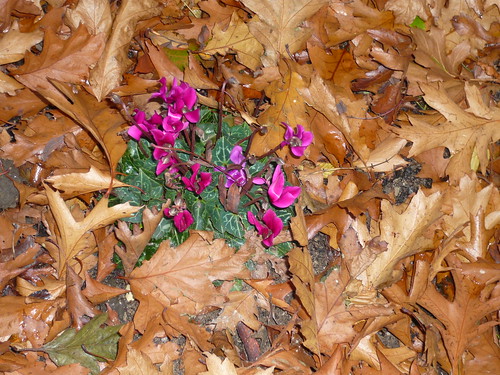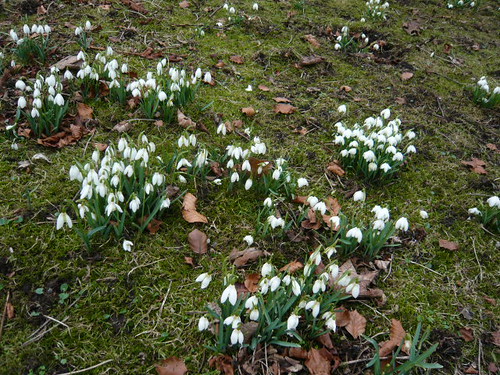Shade Tolerant Plants

Any garden will have a shady corner, there are still many plants we can grow. So rather than reach for the tree pruners try some of these plants.
- Foxgloves (digitalis). Foxgloves are a tall imposing plant offering a long flowering season of attractive bell shaped flowers. They are biennuals which flower in their second year.
- Cyclamen (Cyclamen hederifolium). Cyclamen are delicate low growing plants which flower in winter or autumn, giving a range of flowers. They die back in summer, so don’t forget where they were planted.
- Siberian Squill (Scilla Siberica) This is a bright blue, bulbous perennial which has dazzling nodding flowers in spring.
- Cranesbill Geranium ‘Johnson Blue’ grows in low growing dense clumps which makes it difficult for weeds to grow through.
- Epimediums have pretty, heart-shaped leaves and delicate flowers.
- Lamium (dead nettle) will grow in most shady areas
- Ivy will grow in shady areas, if you just want green ground cover
- Helleborus. One of my favourite plants, great leaves and flowers in the middle of winter
In terms of bedding plants Impatiens, Begonia, are more shade tolerant than most.

More Shade Tolerant Plants
* Abies balsamea, Balsam Fir
* Acer negundo, Boxelder
* Acer rubrum, Red Maple
* Acer saccharum, Sugar Maple
* Acer saccharinum, Silver Maple
* Aesculus spp., Buckeyes
* Betula alleghaniensis, Yellow Birch
* Betula lenta, Sweet Birch
* Chamaecyparis thyoides, American Hornbeam
* Cornus florida, Flowering Dogwood
* Diospyros spp., Persimmon
* Fagus grandifolia, American Beech
* Ilex opaca, American Holly
* Ostrya virginiana, Eastern Hophornbeam
* Picea glauca, White Spruce
* Picea mariana, Black Spruce
* Picea rubens, Red Spruce
* Salix spp., Atlantic White Cypress
* Tilia americana, Basswood
* Thuja occidentalis, Northern White Cedar
* Tsuga canadensis, Eastern Hemlock
* Nyssa spp., Tupalos
Related
Other Resources
Royal Horticultural Society RHS ‘Gardening for All’
National Council for Conservation of Plants and Gardens ‘Conservation through Cultivation.’
Garden Organic National Charity for Organic Gardening.
BBC Gardening
Overhanging deciduous tree Shade
- Rain and light will penetrate during spring and winter.
- Native woodland plants that flower in spring will thrive. Bluebells, wood anemonies, primroses, cyclamen and campion.
- You may need to write off the space during summer or try shade loving geranium phaeum or geranium macrorrhizum
Part of the day shade from wall or tall hedges
- A northish facing border dominated by a wall may get some sun but it will probably not support sun-loving plants.
- Improve the soil with rich, water retaining compost.
- Leave a no-man’s land, between the wall or hedge and plants, where the soil will be poor, sour and or root infested.
- There are many herbaceous perennials that will work here including, Astrantia, Silene, Lamium dead nettles, Lunaria, Euphorbia, Lily of the valley, Hostas, and Japanese anemonies
Deep inhospitable shade for example that found under evergreens
- This is a serious problem where only ivy springs forth and even then a bit reluctantly.
- Try plants in pots that can be watered and moved around to get some time in the sun.
- Ferns or Tree ferns may look OK and should appreciate humidity.
- I have not tried but even more evergreens may work to an extent.



3 thoughts on “Shade Tolerant Plants”
We have a private park in the centre of Brighton where White Letter Hairstreak butterflies have been recently sighted. In addition to the sunnier borders, we want to identify shade loving plants which will attract them and other butterflies. Can you advise? Virginia Monson 18 Park Crescent, Brighton BN2 3HA
In damp shade Busy Lizzies may not have enough nectar for your butterflies but you could try Ajuga (bugle), Mimulus, Dogs tooth violets, Hemerocallis, Meadow Sweet or Astilbe. For dry shade Violets and Viola labradorica, Dead Nettle (Lamiums), Cotoneaster and Privet.
As you know you need a caterpillar host and a source of nectar. I hope this gives you some ideas frpom a shady gardener but also see http://butterflywebsite.com/butterflygardening.cfm
Comments are closed.